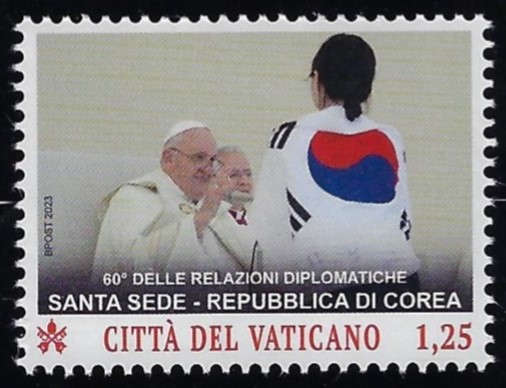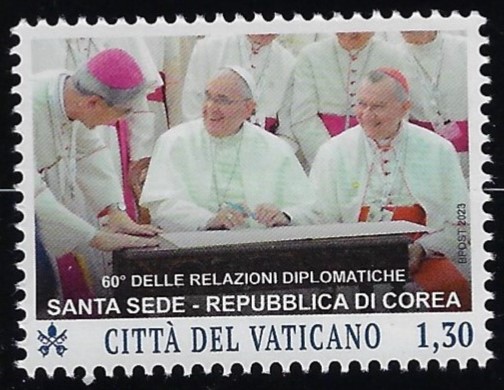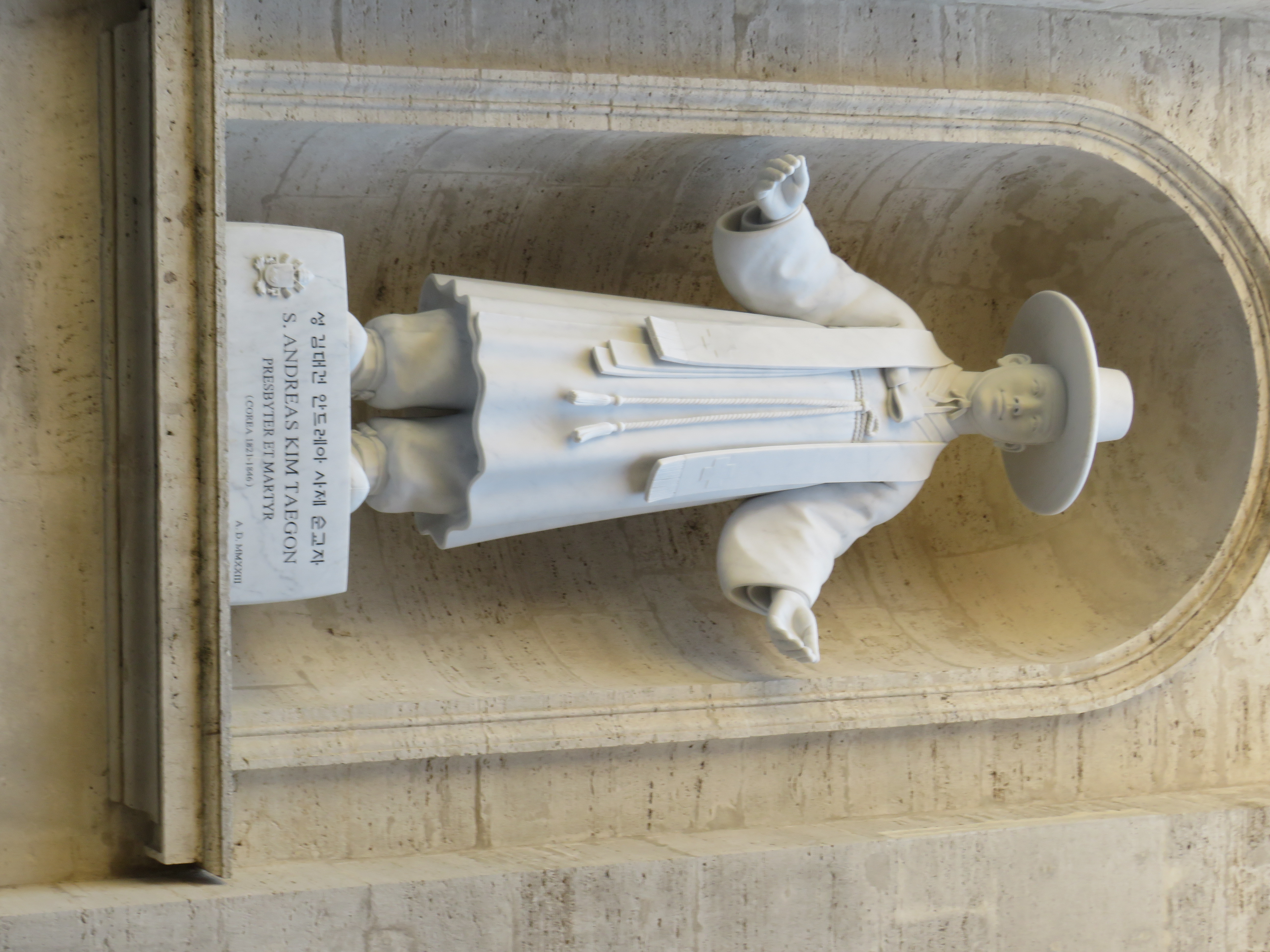
Home

 Dated Issued: November 23, 2023 Perforations: 11.5 x 11.5 Commemorative Series of Two Stamps Photo taken in Lisbon during World Youth Day (August 1-6, 2023) – €1.25 Photo of Pope Francis visit to South Korea (August 13-18, 2014) – €1.30 On December 12, 1948 the Republic of Korea (ROK – South Korea) had “observer” status at the United Nations. Diplomatic relations between South Korea and the Vatican came on December 11, 1963. The Republic of Korea (ROK-South Korea) and the Democratic People’s Republic of Korea (DPRK – North Korea) were both admitted to the United Nations on August 8, 1991. In looking at the diplomatic relations between South Korea and the Vatican along with the Beatification of Paul Yun Ji-Chung and the 123 martyr companions, a context of five important episodes in the history of Korea is needed The events are: the Josean (Choson) Dynasty which began in 1392 and lasted until 1910, Japan’s annexation of the Korean peninsula (1910 – 1945), Korea becoming a divided country almost immediately after the defeat of Japan by the Allies, the Korean War which started on June 25, 1950, and lastly, the armistice of the war. Under the Joseon(Chosen) Dynasty Korea had a monarchical system of government. Confucianism was the state religion. Under Confucianism the people were expected to strive for five virtues: benevolence, righteousness, trustworthiness, propriety, wisdom. The emperors were venerated. There were four hierarchical classes under the emperor: yangban (civil officials, military, the landholding class), chungin (intermediate class), sangmin (common people), and ch’onmin (low-born people). As trade developed, Koreans started to travel to China for commercial trading. On their visits some Korean’s got introduced to Catholic teachings. They brought back books about Catholic teaching and spirituality. The Bible was a source of inquiry for Korean intellectuals. From studying books, Christianity spread. It was lay men and women and not missionaries that the Christian faith spread in Korea. Saint John Paul II makes mention of this in his homily for the canonization of the Korean Martyrs on May 6th, 1984 (Saints Andrew Kim Tae-gan, Paul Hasang and 101 companions – feast day September 20th). “The truth about Jesus Christ….came by means of books brought from China. And in a most marvelous way, divine grace soon moved your scholarly ancestors first to an intellectual quest for the truth of God’s word and then a living faith in the Risen Savior. From the good seed was born the first Christian community in Korea. A community unique in the history of the Church by reason of the fact that it was founded entirely by lay people”. The rise of Christianity was met with suspicion by the Emperor and the ruling yangban class. Their concern was that a belief in Jesus Christ took power away from the Emperor and the yangban. The legalistic class system, which supported the Emperor and the yangban class for over 500 years, was now being undermined by a divine mystery - the birth, life, and resurrection of Jesus Christ. As a result, there were five major sets of persecutions against Christians. These persecutions happened in the years 1791, 1801, 1839, 1846, 1866. In 1884 Christianity became tolerated by the Emperor. During the 500-year history of the Josean Dynasty, there were minor conflicts with China, Russia and Japan. But, the demise of the Josean Dynasty came to an end when Japan rose to be the major power in Asia. In 1910 Japan annexed the Korean peninsula. Japan attempted to eliminate the Korean culture. The Shinto belief of Japan became the state religion. At the same time during this period of conquest, there were a number of Koreans who worked underground for Korean nationalism and the hope of overthrowing Japanese colonialization. Moving fast forward, with the defeat of Japan becoming imminent, the fate of Korea was being discussed at the Yalta Conference in February 1945. US President Roosevelt proposed a four-party trusteeship consisting of the United States, Great Britian, U.S.S.R and the Republic of China. The objective of the proposal was that Korea would eventually become a united country. Before a finalized plan was approved, the U.S.S.R. moved troops against the Japanese forces in Manchuria and northern Korea. With the defeat of Japan and the U.S.S.R. in the northern part of Korea, Korea became a divided nation. The Russian Soviets followed up and set up a communist country in North Korea under expatriate Korean communist Kim II Sung. Kim II Sung served in the Russian army in Manchuria. North Korea is an atheistic county. To a significant degree religious activities, especially Christian, have been considered a crime. Christianity challenges the god-like cult of the Kim Dynasty – Kim II Sung (1948-1994), Kim Jong II (1994-2011), and Kim Jong Un (2011-present). During the three generations of the Kim Dynasty, we do not have figures as to executions and imprisonment of Christians (Catholic and other Christian denominations). The Vatican has no diplomatic relations with North Korea. Pope Francis has mentioned his desire to visit North Korea upon receiving an invitation. The purpose of a meeting would be to create a peaceful existence on the Korean Peninsula especially since threatening military speech and actions have been taking place at the current time. There are underground groups of Christians in North Korea today. Between 1945 to 1948 the US military took responsibility for governing South Korea. In August, 1948 South Korea set up a presidential system which to a large degree is a top-down system of governance. This was especially so in the country’s first 30 years of existence. Religious freedom is guaranteed in its constitution. The early political history of South Korea was rift with corruption, power struggles, unrest and economic hardship. On June 25, 1950 North Korea invaded South Korea. The United Nations condemned the invasion, and the Korean War began. The Korean War ended in an armistice signed on July 27, 1953. The president at the time of the war and until 1956 was Syngman Rhee. Rhee was an authoritarian and dictatorial leader. He ruled with an iron hand. Opposition leaders were contained by force. On May 16, 1961 there was a coup d’état and a military junta headed by General Park Chung Hee took over the government. Today, South Korea is basically a working democracy and an economic powerhouse among Asian countries. The contrast between North Korea and South Korea is significant. The population of North and South Korea is respectively, 26.1 million versus 51.8 million. GDP of North and South is respectively, $16 billion versus $1.721 trillion. Active military personnel in North and South Korea are respectively, 1.1 million versus 639 thousand. The United States has approximately 28,500 military troops in South Korea. Religious affiliation in South Korea is estimated to be 11% Catholic and 18% Protestant with the remaining 73% to be Buddhists, Shamanistic Believers, Confucianism philosophy Believers, and unaffiliated. It is of interest that Saint John Paul II’s canonization ceremony of 103 martyrs in 1984 and Pope Francis’ canonization ceremony of 124 martyrs occurred in Korea and not at the Vatican. History will have to determine the number of Christian martyrs in the 21st and 22nd century under the Kim Dynasties. As said by Popes and other Christian leaders, “Korea is a country of martyrs”. Also, we surely must not forget the American military men and women martyrs who gave their lives in the Korean War. At the meeting with Asian Youth on August 15, 2014, Pope Francis encouraged all Asian youth to pray for peace and reconciliation. He specifically asked for continuous prayers to addressed the division and possible confrontation between North and South Korea. Pope Francis states the following to the youth of Asia: “This afternoon I would like to reflect with you on the theme of the Sixth Asian Youth Day: ‘The Glory of the Martyrs Shines on You’”. Just as the Lord made his glory shine forth in the heroic witness of the martyrs, so too he wants to make his glory shine in your lives, and through you, to light up the life of this vast continent. ……The Gospel teaches us that the Spirit of Jesus can bring new life to every human heart and can transform all situations! This is the message which you are called to share with your contemporaries…….conquer evil with good.” On September 16, 2023 a 6-ton marble statue of the patron saint of Korea, St. Andrew Kim Tae-gon was placed in Saint Peter’s Basilica:  Statue of Saint Andrew Kim Tae-gon Photo by Marvin Lanahan, used with permission References: • Korea Martyrs Wikipedia - https://en.wikipedia.org/wiki/Korea-Martyrs • Encyclopedia Britannica Article – Josean (Chosen) Dynasty, Korea, Five Virtues for a Harmonious Life Lessons from Confucianism • aaKnights of Columbus – http://www.kofc.org/en/Columbia/detail/korea-church-martyrs.html • 6 May 1984, Canonization of 103 Korean Martyrs/John Paul II (Vatican.va) • Apostolic Journey of His Holiness Pope Francis to the Republic of Korea on the occasion of the 6th Asian Youth day (13-18 August 2014)/Francis (Vatican.va) • Holy See celebrates 60th anniversary of diplomatic relations with the Republic of Koea – Catholic News Agency • Remembering North Korea’s Christian martyrs – BBC • Despite Tremendous Odds, Religion Survives in North Korea (voanews.com) • John L. Allan, Catholicism in North Korea survives in catacombs National Catholic Reporter – https://www.ncronline.org/news/catholicism-north-korea-survives-catacombs • America Magazine – Pope Francis wants to visit North Korea to create “momentum for peace” • Religious Beliefs In South Korea World Atlas –https://www.worldatlas.com/articles/religious-beliefs-in-south-korea.html • Christian Persecution in North Korea 🇰🇵 History from 1907 Pyongyang revival to the Kim dynasty rule (youtube.com) Technical Details: Scott Catalogue - 1839-1840 Date Issued - 23 November 2023 Face Value - €1.25 Perforations - 11 ½ Printing Process - Offset 4 colors Printer - Bpost (Belgium) Max Printed - 72,000 complete |